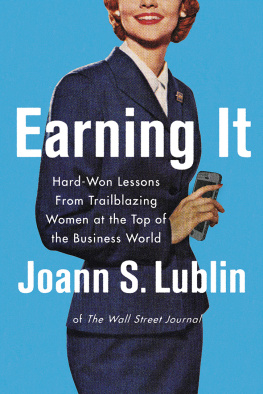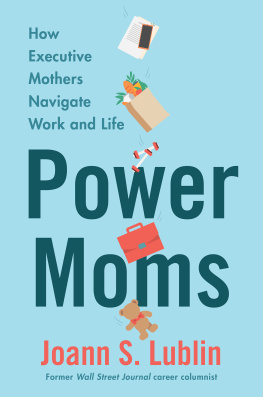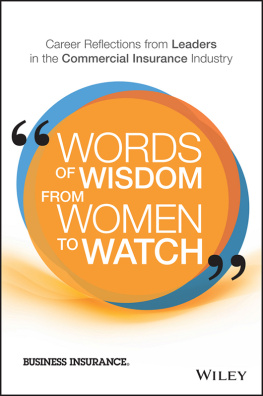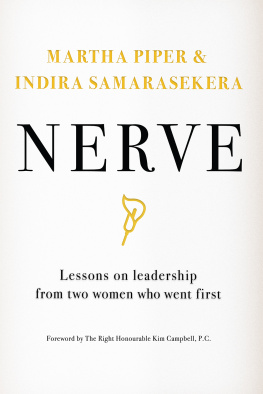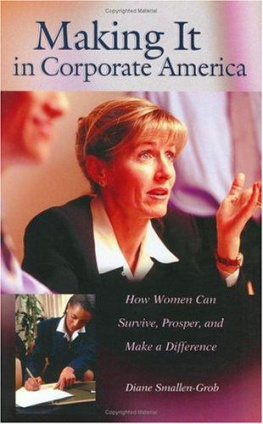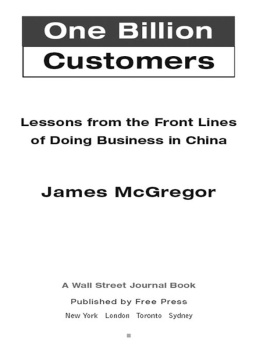Contents
To the most important working woman in my life:
Annie Supman Lublin, my paternal grandmother.
She immigrated alone to the United States at age sixteen and earned
enough toiling in a sweatshop to bring her parents
from Eastern Europe.
Ambitious women today feel little connection with female business executives who overcame obstacles to succeed. Those leaders seem to have catapulted directly into their lofty posts once they got past some setbacks along the way.
But there are powerful parallels between their world and yours, as youll realize from reading my book.
I know this landscape firsthand. In 1969, I became the first female summer intern for the Washington, D.C., bureau of the Wall Street Journal. It was a highly prestigious office of the premier business newspaper in America.
I was thrilled to make my professional debut at such a well-known publication. During my nearly three months at the paper, my byline appeared on five front-page features, including one about citizens unconventional petitions to Congress. And I learned a lot about big-time journalism from my lanky, middle-aged editor. A veteran of twelve years in the news business, he smoked a pipe and demonstrated a deft touch with words.
But my Journal summer stint had an unexpected and unwelcome conclusion. On the day my internship ended, my boss walked me out the door of the office. He then leaned down and kissed me on the lips.
I felt violated. I hardly knew the man. Yet I yearned to be a big-time journalist someday. Mumbling goodbye, I fled the office. I remember thinking, I cant tell anyone what just happened.
I repressed memories of this horrific incident until 1991, when I helped the Journal cover alleged sexual harassment by Clarence Thomas during Senate confirmation hearings for his U.S. Supreme Court appointment. I suddenly recollected my supervisors misbehavior. I shuddered visibly.
Nor was the unwanted goodbye kiss an aberration when it came to sexist behavior in the workplace. I had landed my summer job as a Newspaper Fund intern after Dow Jones & Co., the Journals parent, opened that internship program to female journalism majors like me.
As I entered the Washington bureaus conference room for my first staff meeting, every man rose to his feet. I figured a famous politician had arrived. On the contrary. My male colleagues were standing for me in a chivalrous but distinctly unwelcome gesture that I had never experienced in college.
There were other distasteful moments. I refused one coworkers request to make him coffee. I truthfully explained that I didnt know how to make coffee because I drank tea. He silently stalked off. But I doubt he would have asked a male intern to perform such a menial task.
After completing a journalism graduate degree at Stanford University, I got hired in 1971 as the first female reporter for the Journals San Francisco bureau. I again ran into both subtle and blatant sex bias. Such behavior was socially acceptable during that era.
Where have they been keeping a dish like you? male sources often asked me in a teasing fashion. When I covered events at private business clubs that barred women, I was forced to use a special door, usually one near the kitchen in the rear.
In 1987, I was promoted to second in command of the London bureau. I quickly discovered that sexism still ruled in Britain, despite strides being made in the United States. Bosses there needed special permission to let women work past 10 p.m. in factories. Such laws were originally designed to protect the so-called weaker sex, but hindered progress toward gender equality. And though I made more money than my journalist husband, I wasnt allowed under British law to sign our joint tax return.
These setbacks, while sometimes daunting, didnt discourage me. They emboldened my passion to prove that working women are just as capable as men. I shared the Journals 2003 Pulitzer Prize for stories about widespread corporate scandals that toppled a number of top executives. As the papers longtime management news editor, I have written extensively and overseen other peoples reporting about such topics as women in the workplace, chief executive succession, executive pay, and company boards of directors.
I also inaugurated the Journals coverage of career issues with the 1993 launch of my monthly column, Managing Your Career. I currently write Your Executive Career, a regular advice column that I began in 2010.
Plenty of American working women have pursued similar paths. For a handful at the vanguard, the journey brought them to the corner office of big businesses.
According to Catalyst, a well-regarded organization that conducts research on issues related to women, women ran 4.2 percent of companies in the Standard & Poors 500 Index as of December 2015. Among the twenty-one in this category: Mary Barra, chief executive of General Motors Co., who took the helm in 2014 after moving up through the ranks of the largest U.S. automaker.
Virginia Ginni Rometty also broke the mold, as the first woman to head International Business Machines Corp. Her 2012 promotion came a mere sixty-nine years after the technology giant elected its first female vice president.
Nearly two-thirds of Americans believe that women continue to face a barrier to career advancement, concluded a May 2013 survey by financial services firm Edward Jones. More than 75 percent of millennial women, who reached young adulthood around 2000, identify gender bias as a workplace problem, according to a 2011 poll by the Business and Professional Womens Foundation.
The most common forms cited by the young women? Stereotyping. Unequal pay. Not being treated as an equal. Inequality of opportunities. Being held to different standards. Sexist jokes. And of course, sexual harassment.
Many women reaching the upper rungs of U.S. businesses encountered a variety of setbacks early in their careers. Yet paradoxically, the useful leadership lessons they learned from those challenges propelled their ascent and proved critical to their ultimate success.
A growing number of books promise to reveal success secrets for women, usually based on anonymous examples from many walks of life. But this book is very different.
That is because this book is filled with candid and compelling stories about workplace experiences and advancement advice from fifty-two corporate female leaders. Almost two-thirds of the business titans I interviewed are present or past CEOs of public companies, including seven in command of an S&P 500 concern as of December 2015. Insights from women like them, who reached the pinnacle of management, can help you climb your career ladder.
The executive women whose stories I tell in this book represent a unique elite that has radically reshaped the business landscape in the late twentieth and early twenty-first centuries. They dismantled the old boys club, destroyed myths about capabilities of female leaders, and continue to serve as role models for female associates and relatives.
These trailblazers shared incredible tales of courage, sometimes opening both their hearts and their homes. With great candor, they provided vivid and deeply moving examples of their good and bad work experiences. I met nearly all of the business leaders face-to-face. I describe how they appeared and acted during our sessions so that you can better picture these encounters and understand who these women are. Thanks to them, youll know what to do when you confront the challenges of the workplaceand equally important, what not to do.
The executives I spoke to exuded grit, resiliency, and a determined unwillingness to admit defeat when they confronted career obstacles. Some got fired for their efforts.

